|
| 2006 Featured Articles Archive |
|
|
|
|
|
|
|
|
|
|
|
|
| ~ October 10, 2006 ~ |
| |
Back Country Horsin’ Around Experience
By Pam Bowman |
|
Camping with horses can be the ultimate way to see places in our parks and wilderness areas that one might not experience via hiking or biking. You may experience the pleasure of viewing a large assortment of native wild life in many of the areas that are available to camp and ride. Feel how our forefather felt when coming over a ridge into a pristine valley or view that far away sunset that just takes your stress away as is sets. Wander through a Mighty Oaks grove on a warm afternoon or just amble down the trail beside a cool mountain lake. There are so many wonderful parks throughout California to enjoy just those kinds of adventure. |
Getting started is easy; planning ahead is your best strategy for an enjoyable, safe and exciting adventure. Here are some of the things you should know before loading up and heading to the campgrounds: Research your chosen campground. Contact the park service or organization that manages the camping area to find out what things are available at the camp location such as drinkable water, bathrooms, corrals, trail access suitability for different levels of riders. Also make sure that they allow horses, some campgrounds cannot accommodate horses. Ask if there are trail maps available. Don’t forget to ask how far in advance you may need to make reservations. Some of the more popular grounds are booked many weeks out in prime seasons. Check for any restrictions imposed in the area such as feed restrictions. Some areas restrict the types of feeds that are brought in so as not to upset the native plant life.
Prepare your horse. Make sure you horse is comfortable being tied to the trailer. Make sure he will drink water from new sources. Not all horses will drink when they are away from home and have strange water sources. Camping horses should be experienced in walking on trails and dealing with other trail users such as hikers, bikes and on coming horses; comfortable with restraints of being tied to the trailer or picket line; familiar with loading and hauling; accustomed to standing quietly while being tied; used to crossing downed obstacles and boggy areas; used to the crinkling noises of maps and plastic rain gear; shod; wormed and vaccinated.
Some of the items to bring: saddle pad, bags, saddle, combs, brushes, hoof pick, blanket, halter, lead rope (bringing an extra halter & lead rope is always a good idea), feed and water buckets, breast strap, hobbles(make sure your horse is accustomed to hobbles before trying these out on your camping trip, you do not want a injured horse or handler while out in the field) or a high picket line ( practice this at home as well for safety reasons. Make sure your horse respects being tied in this manner.), grain or oats, hay, fly repellent, fly mask, equine first aid kit and a rake, along with all your camping gear and personal accessories to stay warm, dry and confortable.
And please remember: if you brought it in with you , please take it out with you. Don’t leave trash and debri where you camped or rode.
Camping has taken me to Arizona, California and Colorado with my horses and I just can’t tell you just how much fun I have had in these adventures. I hope you to get to enjoy this avenue of horsin’ around! See ya on the trail!
~ Pam Bowman |
|
| ~ September 8, 2006 ~ |
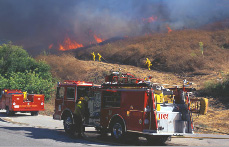 |
“WHY SHOULD I MICROCHIP MY HORSE?”
Disaster Recovery: AVID® has supplied universal scanners to national disaster and emergency preparedness groups in the U.S. Trained personnel work directly with law enforcement to identify rescued horses. When a microchip is found in a horse, the horse is a phone call away from being reunited with its owner. |
| Theft or Loss: The chip number provides law enforcement the equivalent of a 'Vehicle Identification Number' for your horse. It is unique and unalterable, making it court-worthy permanent identification. Universal scanners are used by the USDA equine slaughter facilities, and many auctions are scanning all horses passing through sales. In combination with AVID’s published Hot Sheets of stolen horses, not only is the public alerted, but thieves are deterred. Metal signs, alerting visitors to your barn that, “Our horses are permanently identified with registered AVID® microchips” will be available for sale at the clinic for $10 each. |
|
How long does the chip last? The chip is guaranteed for the lifetime of your horse. It will not wear out or fade. The horse feels nothing at all when it is being scanned. Once inserted, you cannot see or feel the chip.
|
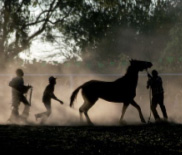 |
|
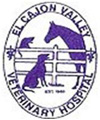
El Cajon Valley Veterinary Hospital,
together with Kevin May, DVM,
ARE OFFERING THE AVID®
“EQUINE MICROCHIP CLINIC”

|
For information about the clinic, contact:
Megan - El Cajon Valley Veterinary Hospital Manager, Large Animal Department
619-444-9491, 619-444-9340 (voicemail), eqjmpr@yahoo.com, www.avidequined.com |
|
| ~ July 7, 2006 ~ |
 |
Keeping your horse cool at the Summer Shows
By Pam Bowman
The show season is heating up…. literally! With summer here, one of the ongoing concerns on hot summer days at the horse show is staying cool. Not only for yourself, but for you horse as well. You have worked hard all season to condition and ready your horse for the show season. You would like him to perform at his best and show the brilliance that you know he can produce. Yet there is no way to predict how hot and humid the show day’s weather will be. Whether hot or cool, these are also circumstances that play into you and your horse’s performance during the show.
Here are some tips for keep your horse cool on those hot summer show days. |
Tip 1: Offer drinking water often. Offer water between each class and at the lunch break. But do not let him gulp all the water he may need in one serving. Too much cool water inside a hot horse is a recipe for colic.
Tip 2: Do not over work your horse at the show. This can bring on dehydration and dull him for his rounds in the classes you have chosen to ride in. He may not be acting as frisky as usual so take this as a sign that he does not need the same amount of time lunging and work under saddle as a cool day at the show.
Tip 3: Between classes, wet your horse’s neck, front legs and inside of the hind legs. Be careful not to wet your horse’s rump as this can potentially cause tying up in a hot horse. This will help to keep his body temperature at a reasonable level so that he does not over heat. Horses can experience heat exhaustion as well. This will also help keep your horse looking fresh for each class.
Tip 4: Check often for his hydration level. This is an easy method of pulling the skin on the neck to see how fast it recovers. This is a pinch test (There is no need to pinch hard, just hold the skin between the forefinger and thumb and pull the skin out, let it go see how long it takes until you do not see where you grabbed it). The faster it recovers, the better his hydration. If it stays “tented” he probably could use a break from work and some water to drink in moderation.
Tip 5: Check with your vet to get an idea whether your horse is a candidate for electrolytes. Ask him when is the best time to administer electrolytes.
Tip 6: How fit is your horse? This is a relevant question to ask yourself before the day of the show. A fit horse will handle the heat and work much better than a horse that is out of shape and maybe a little over weight. This is where planning ahead will really pay off during those hot summer competitions!
|
|
Just remember that if your horse is not having much fun at this show…. the next one he may not give you the performance that you know he is capable of producing. An unhappy, uncomfortable horse will not give you his best! So Keep Cool and have fun at those show! |
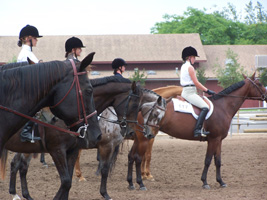 |
|
| ~ May 31, 2006 ~ |
| Trail Travels – Tips for the Travelers |
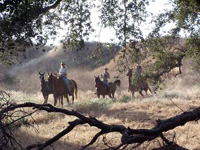 |
Three thousand trailer miles and 400 hoof miles later, Placerville residents Virgil Toothaker and his wife Annabelle can legitimately claim expert status about traveling with horses.
This accumulation of wisdom started in 1996 when Virgil and Annabelle and friends decided to ride their horses on what he calls the Triple Crown of trails: Zion National Park, Bryce Canyon, and the Grand Canyon. Since then, they have traveled with their horses for up to four weeks at a time all over the west, and have developed a safe and sane system for motoring across country with our often willing but frequently finicky equine friends. |
Standing for long hours in a moving, shifting, and rattling box is not normal for horses who need to move pretty much constantly to keep their insides functioning and their legs flexible. Remarkably, horses travel frequently, and live to tell about it. The quest for me is to have the experience be a happy occasion for my horse. For this reason, Virgil’s Trail Travel Tips had a pleasant ring.
“On our first trip, we carried 1,100 pounds of feed with us,” said Virgil in a recent interview. “That’s more than half a ton.”
Virgil found a better way.
“We knew where we were going, and how long it would take us, so we called the company who makes our feed to find out where the feed was sold. We called ahead to those stores to order the feed, and when we passed through town, we picked up our supply just before we camped.” Virgil added this saved a tremendous amount of weight and space, and kept the horses’ diet consistent.
On a long trip, Virgil schedules his overnight stops where everyone can take a day ride, too. This breaks up the monotony and the physical grind of three days straight on the road. Furthermore, you get to enjoy many more trails, Virgil says, adding that each little ride has something unique.
Virgil has found that county fairgrounds make excellent stopovers in cities as they have safe facilities for horses and allow self-contained campers to park. He says most of the time they just show up without any advance reservations, and they are quickly accommodated.
When not near a fairgrounds or horse campground, they find a large, unfenced area in National Forests near the road, pull off and set up camp. They carry electric fences for the horses. He has a spool of wire, small stakes, and a 12 volt fence unit mounted in the trailer supplied by a 20 amps circuit from the truck. |
“We like the electric fencing for a number of reasons,” Virgil explained. “They have minimal impact, we can adjust the size and shape to fit the space or to make sure the horse doesn’t eat too much grass, and if a horse needed to escape from a bear or buffalo, it could.” Virgil recalls reading about incidents in South Dakota when a tied horse, unable to flee, was attacked by a buffalo. “I’d rather have my horse running loose than be a sitting duck.”
“We like to off-load the horses every four hours, or two hours when we’re on windy mountain roads,” he said. At the stop, he and Annabelle hand walk the horses for a little while, and offer them water. They will feed the horses in the trailer during the day at rest stops. And they seldom travel for more than eight hours in a day. |
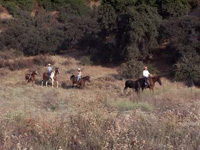 |
Several months ago, I learned that government agents are stopping vehicles with horse trailers to check for proof of ownership of the horses. Virgil confirmed that traveling papers are required when crossing state lines, so they always carry paperwork on the horses.
“When you leave a state, you must show Coggins Test results and have a health certificate for each horse dated within 30 days of the start of the trip,” he said. Some states ask for brand inspection documents, others don’t. He recommends checking with the states you will travel in to know what paperwork is required.
“We always pull in to the livestock inspection stations,” he said. “Usually, the inspector just waves us on. One time we tried to show the inspector the papers, and she didn’t know what to look for.”
On their very first trip, Virgil’s horse, a tall white appaloosa nick-named Sweety Pie, threw a shoe. They were at Bryce Canyon, and were able to find a wrangler who did shoeing. Fortunately, he solved the problem. Since then, Virgil has carried two pre-made shoes for each horse which he can install himself, in an emergency.
“Of course, we have never had another problem. The key is, carry it with you and you won’t have to use it.”
In the trailer, they carry basic medications including antiseptics, bute, banemine, vet wraps, Novocain for suturing minor injuries, and electrolytes.
Virgil says he and Annabelle and friends take a full year to plan out the trip, starting first with the destination, then backtracking to find stopovers with interesting trails of their own and within a reasonable travel distance. Reservations are a must at parks and horse camps if you stay there. They also purchase trail or topography maps, available on the Web, of all the areas they will ride. Then they make arrangements at various feed stores to pick up the feed, and they’re ready to go. |
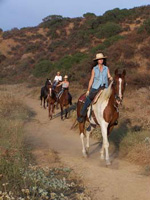 |
“We’ve had many fantastic trips,” Virgil said The longest trip took them through the Grand Tetons where they camped in meadows and aspens, lunched at 9,500 feet, and watched the sunrise sparkle on the Grand Tetons themselves. They traveled through Jackson Hole and Yellowstone, and finally arrived at Roosevelt Park in South Dakota. “It was absolutely gorgeous riding through the gorges, crossing the Missouri River, and riding up on the plains’ sea of grass,” he said.
He recalls a special occasion at Bryce. “We had ridden out during the day on Peek-a-boo Trail. We knew where it would go, so we came back to camp, had dinner, then went out again later in the dark beneath a brilliant full moon. What a difference! All those amazing rock formations took on an entirely different and sometimes eerie character when bathed in the soft moonlight. Like a trip into your imagination.” |
Virgil rides for pleasure, preferring to stay at a camp rather than packing in. “I like to enjoy the beautiful scenery and the incredible trails,” he said. “I don’t want to spend my time setting up and breaking down a camp.”
Annabelle rides endurance, so both riders are well-prepared and well-conditioned for long rides, as are the horses. “This is a vital consideration when you’re asking your horse to do these trips. Make sure you set them up for a good trip by having them be in good condition and well-accustomed to getting in and out of the trailer. A day ride may be between 15 and 30 miles. We generally plan for a 20 mile ride, if possible.”
This year, they plan to go back to Bryce Canyon where Annabelle will ride in an endurance contest.
Their motto on their number plate: “Seeing America on horseback.” According to Virgil, “I like to add, ‘before it closes.’ If we hear some area is going to be closed, we try to make that part of our destination. It’s happening all over.”
Virgil thinks he may publish all their exploits on a Web site some day. He’s thinking of calling it TravelswithSweety.com. |
|
| ~ April 27, 2006 ~ |
| Horse Protection Listening Session |
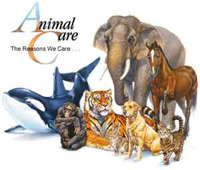 |
There will be a USDA Listening Session in California. It will be on June 12, 2006, at the Kellogg West Conference Center, 3801 West Temple Avenue, Pomona, CA 91768. Registration (to speak) for this session will be on site and begin at 2:30 p.m.
The purpose of the meetings are to: 1) Gather public input regarding the next Operating Plan; 2) Gather public input about the future direction of Horse Protection Act enforcement; and 3) Share information with the public about past, present, and future activities of the Horse Protection program. |
USDA will first present an overview of the Horse Protection Program, followed by an open microphone session for people to share information with USDA. A transcription service will be present to capture all comments on paper, which will in turn be posted on Animal Care's Horse Protection web page: http://www.
aphis.usda.gov/ac/hapainfo.html
Anyone interested in horses regulated by the Horse Protection Act are encouraged to attend and share their thoughts. Questions about the Listening Session can be directed to:
Darby G. Holladay
USDA-APHIS
Legislative and Public
Tel: (301) 734-3265 You can view more info here: http://www.aphis.usda.gov/ac/hpainfo.html |
|
| ~ March 28, 2006 ~ |
| Stabling with a Little Savvy |
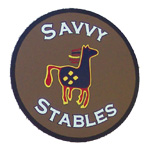 |
North County's newest horse stabling facility is more than just a place for owners to park their horses between visits; it's a natural horse-man-ship oasis for both horses and their owners. Savvy Stables offers boarding, with a variety of large enclosures, pasture for turnout, plus a round corral and riding arena. However, going beyond the basics, Savvy Stables also provides a unique environment designed specifically for the natural horse-man-ship enthusiast. They have designed a ten-acre natural obstacle course, “Playland”, to challenge and enhance your ground and riding skills. |
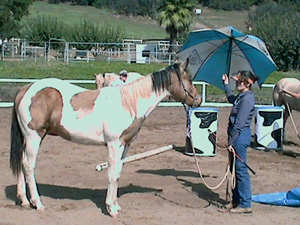 |
|
| Savvy Stables held the first of many playdays on March 4th, 2005. Fun was had by all. We started with a warm up in “Playland”. Then onto the games. Horses and riders alike were challenged by the wash rack with the patriotic streamers hanging down, and were a bit skeptical to climb onto the loading dock made of eucalyptus logs and sand. We had a tie breaker, with Margit Deerman and Joe, her horse being the winning team. They both received prizes. |
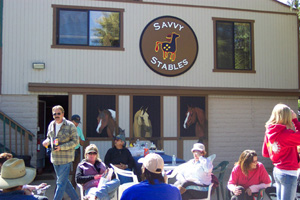
We ended the day with a scrumptious barbecue! |
Speaking of Margit Deerman, she is a Two Star  Instructor and Savvy Stables is proud and thrilled to have her hold monthly clinics and lessons here. Instructor and Savvy Stables is proud and thrilled to have her hold monthly clinics and lessons here.
Next Clinics: April 8th, and 22nd, 2006
Next Playday: May 6th, 2006
For more information
please call 760-751-2073
or
email us at
naturalbreeding@msn.com |
|
| ~ March 1, 2006 ~ |
| Backcountry Horsemen of California presents the 13th Annual Rendezvous |
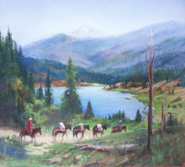
Open Spaces, Camping Places, Willo Balfrey |
When: Friday – Sunday, March 24 – 26, 2006
Where: Stanislaus County Fairgrounds, Turlock California
Why: An Equine Extravaganza for horse and mule folks of all persuasions
Contact: www.bchc.com; Chip Herzig at 951-769-3781; www.jbpresents.com
|
| If you have a manty, bring it with you. If you can work with a lash cinch, you can enter the one-person scramble at the 13th Annual Backcountry Horsemen of California Rendezvous, an equine extravaganza for horse and mule folks of all persuasions. If you want to learn about these seemingly exotic notions, you can join a short class or watch a clinic during the three-day event.
From March 24 – 26, 2006, trail riding and backcountry packing enthusiasts will gather at Stanislaus County Fairgrounds in Turlock, California to revel in the camaraderie of the hard-working, fun-loving folks who love the Open Spaces and Camping Places, this year’s theme.
“Anyone can do this,” said BCHC President Chip Herzig of the San Gorgonio Unit. “Our Packing 101 class will show everyone how to do it from scratch.”
The three-day event offers classes in backcountry riding, vendors with tack, pack equipment, and gifts, and contests such as packing a load, balancing a load, eagle eye horseshoeing, and speed hitch.
“There will be plenty of old west flavor,” said Herzig. “My favorite is Dutch Oven Cooking – we get to taste the real flavor.”
A major feature will be the auction of a trained mustang, provided by the BLM. Visitors can also buy raffle tickets for a 60-foot round pen and a custom-made saddle.
According to Herzig, Rendezvous features fun events and demonstrations which bring families outdoors to play and work together.
“You can learn a whole lot and just have a great time just watching the contests or visiting with the vendors,” said Herzig.
The Western Art Show will include paintings, photos, leatherwork, knitting, carving, and arts and crafts, most of which can be purchased from the artists.
Three major trainers will be on hand to present clinics in working with horses and mules in the backcountry. Jerry Tindell, a regular at most Rendezvous gatherings, will work on how to pony pack stock while staying safe. Matt Sheridan, a fifth generation horseman, will focus on teaching others to have responsive horses. Lou Moore Jacobsen, one of the few female trainers in this field, will help keep rider and horse working together.
The registration packages are available at no cost by calling (951) 769-3781 or visiting the Web site at BCHC.com. One-day registration runs from $7 on Friday and Sunday to $10 on Saturday. Children under 10 can enter free. |
|
| ~ January 20, 2006 ~ |
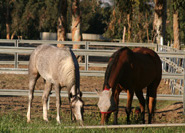 |
A report commissioned by the American Horse Council in 2004 has produced some very valuable information on just how large the equine industry is here in the United States. Did you know that we have over 700,000 horses in California? We have the second largest horse population in the United States (Texas is the largest with 1,000,000 horses). There are 9.2 million horses estimated to be in the United States. This horse industry economically impacts the US economy by contributing $102 billion and supporting 1.4 million full-time horse related jobs. |
This is amazing how the numbers have grown from the early part of last century when the horse was much more involved with the building, producing and transportation in this country to today’s numbers. It was estimated that in the early part of last century that there were less than 30,000 horses nation wide as the Model T and gas engines took hold.
Today the California equine industry is truly thriving and growing with interests in everything from the pleasure backyard horse, performance horses, racing to the show and performance ring. Even with big development pushing horse facilities out of metropolis, the horse is here to stay.
Find what you are looking for right here in www.SoCalEquine.com. The Southern California Equestrian Directory is the largest source of equestrian suppliers, products and services right here in California.
To read more info on this report visit www.horsecouncil.org |
|
 |
| The Rainbow Riders have thrilled audiences with their exciting pace and precision drill since 1986. Founded in Ramona, California by Dottie Pierce and her late mother, Dee Miller, 2006 marks the 20th Anniversary for the team.
The Rainbow Riders is a non-profit organization made up of women of all ages that come from all walks of life. Small business owners, accountants, teachers, homemakers, etc. meet twice per week to rehearse the accuracy for which the Rainbow Riders Team is famous. The Team performs a high-speed, precision drill with intricate, and at times gripping maneuvers, filling the arena with beautiful women and fast horses in a swirl of rainbow colors. They never fail to bring cheers and ovations from audiences young and old, and fans never fail to seek out Team members after performances for autographs and pictures.
The Team makes over 40 appearances per year at rodeos, Grand Prix events, Olympic trials, and many other equestrian activities throughout Southern California. In addition to performing, the Team hosts other social activities throughout the year such as trail rides, BBQ’s, camping trips, and holiday parties to include the entire family.
“We feel that the friendships we make and the camaraderie that is built through our extra-curricular activities helps to build a strong team,” says Dottie Pierce, Captain. “The members of the team work very hard throughout the year to keep the drill exciting. It is important that they trust each other in and out of the arena.”
The Rainbow Riders were proud to be the top performing drill team at the Western States Drill Team Competition in Reno, Nevada three years in a row and once in Los Angeles, California. They made their movie debut as extras in the made-for-television movie Horses & Champions and have been featured in Riding Magazine and Horse Illustrated. The Team has received endorsements from rodeo legend Casey Tibbs, PRCA Stock Contractors, and ten-time National Finals Rodeo announcer Bob Tallman. The Rainbow Riders appreciate their fans and their supporters.
In addition to paid performances, the Team donates time each year for programs in schools, military family events, and local children organizations, including the physically handicapped. The Rainbow Riders have proudly performed for troops returning from Desert Storm and by invitation from the federal government for the Soviet Navy during a 1990 friendship visit to the United States. The team also performed at various fundraisers for the US Olympic Equestrian Team and the San Diego Zoological Society.
The Rainbow Riders invite female riders 18 years of age or older at any skill level to join the Team. Practices begin Tuesday, January 17th and will continue every Tuesday and Thursday throughout the year. Practice is held at Dottie Pierce’s arena in Ramona:
|
Dottie Pierce
454 Steffy Lane (corner of Keyes and Steffy)
Ramona, CA 92065
760-788-4594
dpierce@rainbowridersdrillteam.com
Warm-Up: 6:00 p.m. – 6:45 p.m.
Practice: 6:45 p.m. – 8:30 p.m. |
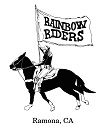 |
If you are looking for something new for you and horse and want to make new friends, give us a call! Please visit our website at www.rainbowridersdrillteam.com for more information. |
|
| Return to Featured Articles Archive |
| |
|
|